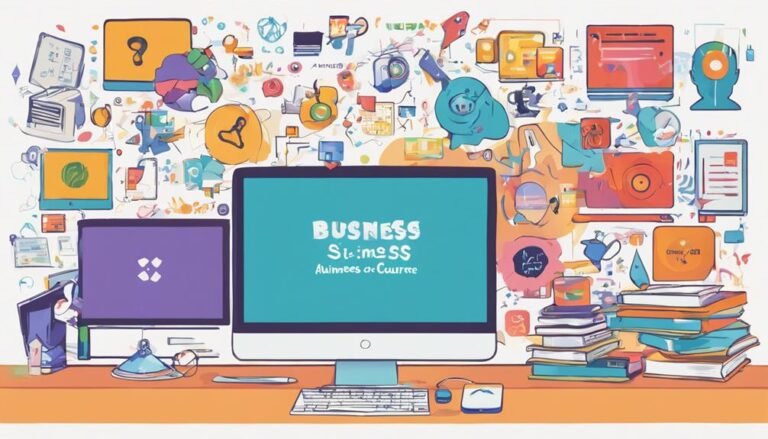What Are the Benefits of Using Video Content in Online Courses?
Using video content in online courses provides a multitude of advantages that can greatly enhance your learning experience. From increased engagement and improved retention to fostering stronger connections between instructors and students, video content offers a dynamic platform for interactive and personalized education. The benefits extend beyond conventional teaching methods, offering a more immersive and flexible approach to acquiring knowledge. Would you like to explore how video content can revolutionize your online learning journey?
Key Takeaways
- Enhanced student engagement through interactive content.
- Improved information retention with visual and auditory stimuli.
- Appeal to diverse learning styles with multimedia content.
- Simplification of complex concepts via visual representations.
- Fostering instructor-student connection with personalized interactions.
Enhances Student Engagement
By incorporating video content into online courses, you greatly enhance student engagement, leading to a more interactive and dynamic learning experience. Interactive quizzes and virtual labs are two powerful tools that can be seamlessly integrated into video content to boost engagement levels. Through interactive quizzes, students can actively engage in evaluating their understanding of the material, receiving immediate feedback that reinforces learning. These quizzes can be designed to adapt to each student's pace and level of comprehension, providing a personalized learning experience.
Similarly, virtual labs offer a hands-on approach that allows students to apply theoretical knowledge in a practical setting. By simulating real-world scenarios, virtual labs enable students to develop critical thinking skills and problem-solving abilities. The immersive nature of virtual labs keeps students actively involved in the learning process, fostering a deeper understanding of the subject matter.
Facilitates Better Information Retention
Utilizing video content in online courses enhances information retention by providing visual and auditory stimuli that reinforce learning concepts effectively. When you watch videos that complement course materials, it improves retention by engaging multiple senses, making the content more memorable.
The combination of audio and visuals boosts comprehension, helping you grasp complex topics more easily. Research indicates that information presented through videos is retained better compared to traditional text-based learning, as videos offer a dynamic way to present information that captures your attention and sustains engagement.
By incorporating video content into online courses, educators can cater to different learning styles, ensuring that you retain key information for longer periods. The interactive nature of videos allows you to pause, rewind, and revisit specific sections, reinforcing your understanding and retention of significant concepts.
Hence, incorporating video content in online courses not only enhances engagement but also facilitates better information retention, ultimately enriching your learning experience.
Appeals to Diverse Learning Styles
Enhancing your online learning experience, video content appeals to diverse learning styles by providing a dynamic and interactive platform for engaging with course material. Video content caters to various learning preferences, making it an effective tool for all types of learners. Here's how it benefits you:
- Visual appeal: Video content utilizes graphics, animations, and demonstrations to enhance understanding, appealing to visual learners who grasp concepts better through images.
- Cognitive learning: Videos stimulate cognitive processes by presenting information in a structured and logical manner, aiding learners who prefer organized content for better comprehension.
- Interactive videos: Incorporating quizzes, polls, and interactive elements into videos supports auditory learners who learn best through listening and engaging with content.
- Auditory learners: Video content with clear narration and explanations benefits auditory learners, helping them process information through sound and speech.
Simplifies Complex Concepts
When tackling intricate topics, video content can be your best ally. It simplifies complex concepts by breaking them down into visual representations that enhance understanding.
Engaging learners effectively, videos make it easier to grasp challenging ideas by presenting them in a dynamic and interactive format.
Enhances Understanding Through Visuals
Engaging visual aids in online courses help simplify complex concepts, making learning more accessible and enjoyable for students. When you encounter intricate topics, visuals can greatly enhance your understanding by breaking down information into digestible parts. Here's how:
- Promotes Cognitive Processing: Visual aids stimulate your brain, aiding in better processing and comprehension of challenging material.
- Facilitates Multimedia Learning: Combining text with visuals creates a dynamic learning experience, engaging multiple senses for improved understanding.
- Enhances Information Retention: Visuals help reinforce learning by providing a memorable reference point for recalling complex concepts.
- Encourages Active Participation: Interactive visuals encourage you to engage with the content actively, promoting better retention and understanding.
Engages Learners Effectively
To effectively engage learners and simplify complex concepts, incorporating interactive visuals is key to enhancing the learning experience. Interactive learning allows students to actively participate in the educational process, leading to improved knowledge retention and understanding.
By integrating visual stimulation such as videos, animations, and infographics, learners are more likely to stay focused and absorb information effectively. Complex topics can be broken down into digestible segments through interactive visuals, making it easier for students to grasp challenging concepts.
This engagement not only enhances the overall learning experience but also fosters a deeper connection with the material being presented. Incorporating interactive elements and visual aids can transform online courses into dynamic and engaging educational experiences.
Fosters Instructor-Student Connection
When incorporating video content into your online courses, you'll find that it enhances personal interaction between you and your students.
This increased connection leads to higher student engagement levels, making the learning experience more dynamic and effective.
Enhances Personal Interaction
Connecting with your instructor through video content in online courses can profoundly enhance your learning experience and foster a sense of personal interaction. Video content allows for a more engaging and personal connection, enabling improved communication and collaboration between you and your instructor.
Here are some ways video content enhances personal interaction:
- Facial Expressions: Seeing your instructor's facial expressions can help convey emotions effectively.
- Tone of Voice: Hearing the tone of your instructor's voice adds depth to the communication.
- Body Language: Observing body language cues enhances understanding and connection.
- Real-Time Feedback: Instant feedback through video fosters a more interactive learning environment.
These elements combined create a richer learning experience, making the online course feel more personal and engaging.
Increases Student Engagement
Engagement with video content in online courses greatly enhances student participation and strengthens the bond between instructors and learners. By incorporating interactive quizzes, students are actively involved in the learning process, allowing for immediate feedback and a more dynamic educational experience. This engagement fosters a sense of connection with the course material and encourages deeper understanding.
Additionally, gamified learning techniques, such as incorporating game elements into educational content, make the learning process more enjoyable and motivating for students. As a result, students are more likely to stay focused, retain information better, and feel a stronger connection to the instructor, creating a more fulfilling online learning environment.
Builds Rapport Quickly
To establish a strong rapport quickly in online courses, incorporating video content allows instructors to connect more effectively with students, fostering a sense of trust and engagement from the outset. Videos create a personal touch that written text alone can't achieve. They humanize the instructor, making them more relatable and approachable. Through visual cues such as facial expressions and tone of voice, instructors can convey empathy and enthusiasm, making students feel more connected to the course material. This connection builds a positive learning environment and encourages active participation.
Here's how video content helps in building quick rapport:
- Showcases personality and passion
- Enhances non-verbal communication
- Creates a dynamic learning experience
- Encourages student interaction
Increases Course Accessibility
By incorporating video content into online courses, the accessibility of the course materials is greatly enhanced. This enhancement not only increases accessibility but also improves retention rates for learners. Video content provides a multi-sensory experience, allowing you to engage with the material through both visual and auditory channels. This can be particularly beneficial for diverse learners who may struggle with traditional text-based content. Additionally, video content can be paused, rewound, or replayed, giving you the flexibility to learn at your own pace and revisit challenging concepts as needed.
Moreover, video content can be accessed from anywhere with an internet connection, enabling you to learn on-the-go or at times that are most convenient for you. This flexibility eliminates barriers related to time and location, making education more accessible to a wider range of learners. By incorporating video content into online courses, educators can make learning more engaging, interactive, and inclusive for all participants.
Encourages Active Participation
Encouraging active participation in online courses is vital for enhancing your learning experience and retention of course material. By actively engaging with the course content, you can deepen your understanding and make the learning process more enjoyable.
Here are some ways video content encourages active participation:
- Interactive Quizzes: Video content often includes interactive quizzes that allow you to test your knowledge and receive immediate feedback. These quizzes not only reinforce key concepts but also keep you actively involved in the learning process.
- Group Discussions: Some online courses incorporate group discussions where you can interact with your peers, share ideas, and gain different perspectives. Video content can serve as a catalyst for these discussions, sparking meaningful exchanges and collaborative learning.
- Hands-On Activities: Videos can demonstrate hands-on activities or experiments that you can follow along with, promoting active learning through practical application.
- Real-World Examples: Video content often includes real-world examples that illustrate theoretical concepts, making the material more relatable and engaging for you.
Provides Flexibility in Learning
Flexibility in learning with video content allows for personalized study schedules and adaptable learning environments. With interactive activities and self-paced learning, online courses become more engaging and tailored to your needs. Video content offers the flexibility to pause, rewind, or fast forward through lectures, accommodating various learning speeds. You can choose when and where to study, fitting your education around your busy schedule.
By incorporating interactive activities, video content keeps you actively engaged in the learning process. These activities can range from quizzes to discussions, enhancing your understanding of the material. Additionally, self-paced learning enables you to revisit challenging concepts as many times as needed, ensuring a thorough comprehension of the course content.
To visually represent the benefits of flexibility in learning through video content, consider the following table:
| Benefits of Flexibility in Learning with Video Content | |
|---|---|
| 1. Personalized study schedules | 2. Adaptable learning environments |
| 3. Interactive activities | 4. Self-paced learning |
| 5. Enhanced engagement |
Embrace the flexibility offered by video content in online courses to create a customized learning experience that suits your individual needs.
Boosts Overall Course Satisfaction
Enhance your overall satisfaction with online courses by recognizing how video content elevates your learning experience. Video content not only improves comprehension but also boosts motivation, leading to a more fulfilling educational journey. Here's how video content enhances your course satisfaction:
- Engaging Visual Learning:
Videos provide a dynamic way to present information, making complex topics easier to understand and retain.
- Interactive Elements:
Incorporating quizzes, discussions, or interactive elements within videos can enhance engagement and reinforce learning.
- Personal Connection:
Seeing and hearing instructors through videos creates a sense of connection, making the learning experience more personal and enjoyable.
- Flexible Learning:
The ability to pause, rewind, and rewatch video content allows you to learn at your own pace, reducing stress and increasing satisfaction with the course.
Conclusion
So, you thought online courses were just boring lectures and endless reading, huh? Think again! Video content is the secret sauce that spices up your learning experience, making it engaging, interactive, and unforgettable.
With video, you'll retain more information, connect with your instructors, and have the flexibility to learn at your own pace. Say goodbye to dull courses and hello to the exciting world of online learning with video content!







